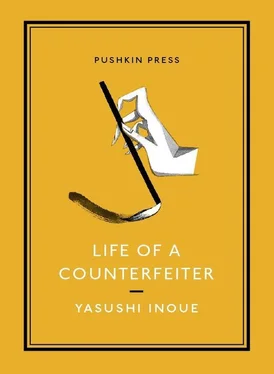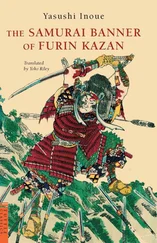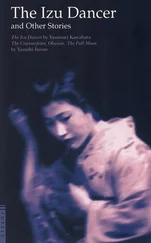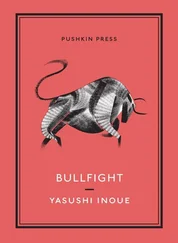Takuhiko treated it as a joke, but Keigaku seems to have given Hōsen money more than just once or twice. Takuhiko remembered hearing this from his father and mother, and the faint recollections that came when he cast his thoughts back to the two other times he had seen Hōsen, if that’s who it was, suggested that the man had either come to borrow money, or been summoned for a scolding by his father — something like that, in any event, must have been responsible for the way Hōsen hung his head when he left, judging from the mood of the scenes Takuhiko had peeked in on.
“That time I saw him prostrating himself, unable to look up — I don’t think he ever appeared in my father’s presence again after that,” Takuhiko said. “Once I started middle school, I never heard my old man mention him visiting, and when he did talk about him it was always in a very retrospective sort of mode. ‘I had this friend once, a real bad character…’ That kind of thing.”
We stayed up late that night, drinking before that painting of Hara Hōsen’s, and then spread our futons out on the floor in front of it and went to sleep.
The second time I encountered Hara Hōsen’s name was near the end of the war, in the spring of 1945, which makes it about a year and a half after Ōnuki Takuhiko and I went on our trip around the towns along the Inland Sea. During that period there had been a dramatic shift in the direction of the war, and the country had become almost unrecognizably gritty and desolate: people’s day-to-day lives, their hearts, even nature itself had changed.
I had evacuated my mother, my ailing wife, and our two small children to a village near the ridge of the Chūgoku mountains, relying on the good graces of an acquaintance there of one of my colleagues at the paper. The place was about as isolated as it could be, located near the area where Okayama, Hiroshima and Tottori prefectures abutted each other and falling just within the borders of the last. No matter how the war ended, it was the sort of spot where life would keep rolling placidly along, day after day, just as it had since ancient times.
I went for a first visit to get a sense of the area, before shipping my family off in late March. The only person I had any connection with there — the acquaintance of my colleague upon whom I would be relying for help — was a man named Ogami Senzō.
The eight-kilometer road that led to the village from the station at the summit, on the Hakubi line, was incredibly steep, just barely wide enough for one person, and I had to cross two small peaks on the way; once I entered the village, though, the land was so level it was difficult to believe it was on a mountainside, and the view was wide open in every direction. The sunlight and the scent of the wind were totally different from down below. Fifty or so houses dotted the spacious plateau, and the whole settlement brimmed with a light so free from any shadows that it actually left me feeling a bit empty. For the first time, up there, I experienced the sensation of light raining down from the sky. A shallow river perhaps nine meters across ran down the center of the plateau; it was hard to tell at first glance which was upriver and which was downriver, though in fact it was flowing north.
Still in his farming clothes, Ogami took me to see the village Youth Center — a building hardly any different from the farmhouses, despite its name — which we had been told we could rent, and I decided immediately to take it. That night I stayed with the Ogamis. Every household in the village had done so well with its fields that you would have been hard pressed to find such wealthy farmers elsewhere: each family owned two or three cows, and their houses were built in an old, unfussy style. Evidently the Ogami family could trace its roots back further than any other in the village, and their house was a size bigger than the rest. The room where they let me sleep was separated from the storage area by a sliding door fashioned from a solid board of Japanese cypress.
And in this room, in the incongruously small half-mat alcove, I discovered a picture of Keigaku’s: a fox beneath a peony, turning to look this way. I was startled to see it there. As wealthy as they were, this was hardly a picture one would expect to find in a farmhouse up in the mountains.
“That’s quite a piece you have there,” I said to Ogami. He was in his fifties, and looked like the last man you would expect to have anything to do with painting.
“Yes, I hear it isn’t the kind of thing people like us can often get hold of…” For some reason, Ogami’s deeply suntanned face, with its simple, rugged air, had taken on a bashful coloring. “Happens there was a fellow in the village who used to be his best friend,” he said. “The painter’s, I mean. It’s a man named Keigaku who did it.”
“What was this friend’s name?” I asked.
“Hara Hōsen he was called. He was a painter, too. Died back in 1940, though, if memory serves. From these parts originally, and came back home at the end of his life.”
I required no further explanation — everything was clear. I was surprised to learn that Hara Hōsen had come from this area, I must say. And even though he was a perfect stranger, hearing that he had died touched a certain chord in me, if only very faintly. Just one year after Keigaku had passed away, his counterfeiter, Hara Hōsen, had followed.
That evening, I wrote a letter to mail to Kyoto, where Ōnuki Takuhiko was no doubt fraying his nerves day and night, rushing to move the enormous collection of artworks his father had left behind out of the city. I told him that Hōsen was dead, and that by some strange trick of karma it looked as though my family would be evacuating to his hometown.
About a month later, I moved my family to the village. Deep-purple flowers were blooming on the akebia vines in the thicket behind the Youth Center, where the four all-but-helpless members of my family were to live. April was almost over, but the air was still chilly, and when I dipped my hand into the stream that ran past the house the water was as cold as in winter.
I spent about five days helping my family get settled in before returning to Osaka, and on one of those days I went to pay my respects at the house of the village head, whose family traced its roots in the area back almost as far as the Ogamis. In the reception room, I came across another of Hōsen’s counterfeit Keigaku’s — the second I had seen in the village. This one was a 240-centimeter picture of birds and flowers, and although it was a fake it was quite forceful.
Needless to say, I kept quiet about the pictures, revealing their secret neither to the Ogamis nor to the village head. I had absolutely no desire to push unwanted information upon people who believed they owned a painting by Keigaku at a time when the very survival of the nation was in doubt. In all likelihood, their Hōsen — Keigaku forgeries would never leave this mountaintop village; for hundreds or perhaps even thousands of years, they would pass from hand to hand, from one person who had never even heard of Ōnuki Keigaku to the next. This wouldn’t change, no matter what became of the country, I thought. And all of a sudden, I felt — though the feeling lasted only as long as the thought — that I was in the presence of something eternal. My distress as I prepared to entrust my family to this unfamiliar place, in these times, plunging them into a world of unknown feelings, unknown customs, had left me feeling altogether different about those counterfeits than I had a year and a half ago.
I visited the village three times to check on my family between then and the conclusion of the war in August. On the third of those trips, I think it was, I went to inspect another empty farmhouse in the village for that same colleague at the paper, guided by the old, bent-over woman who was looking after it. The house stood on a low rise at the village’s south end, where the land began sloping gently up and down; apparently it was higher than any of the others, and it was set apart from the settlement, all on its own. I was surprised to learn from the woman that this was where Hōsen had lived. Almost five years had passed since he died, but it had been left undisturbed, uninhabited.
Читать дальше












